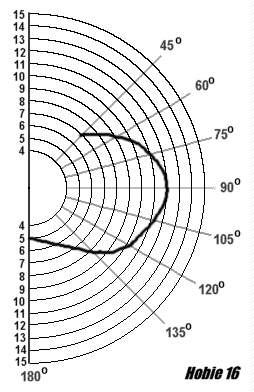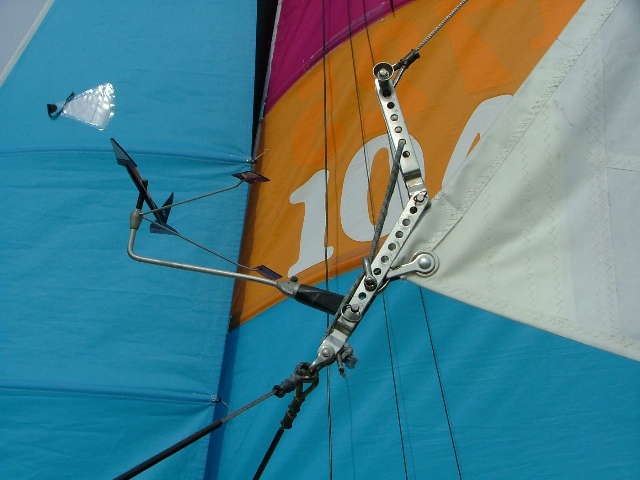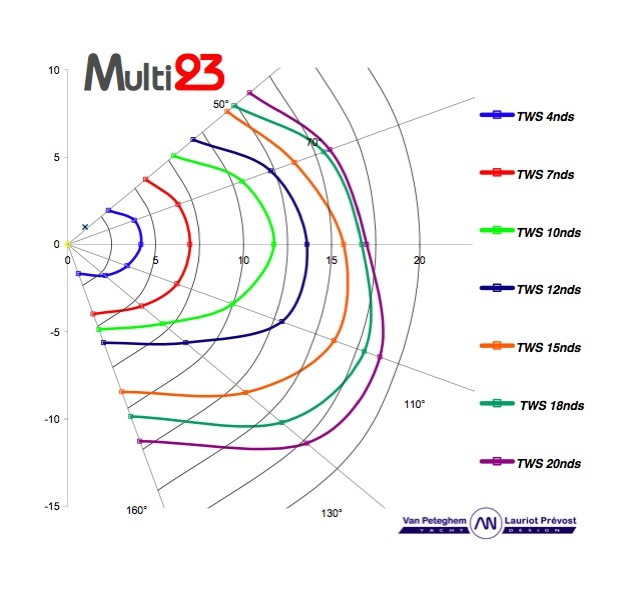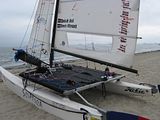IMHO, many beginners get hung up on trying to make all the telltales fly at the same time. With the complex flows across the sails, they almost never will.
If you plotted boat speed vs. angle to the wind, you'll end up with something like this:

There's no continuation of the plot line to 0° because the line would go almost straight to zero - like falling off a cliff. You can feel this "corner" on the plot when sailing - the boat loses speed rapidly.
When setting up a Hobie 16 for the first time on the beach, I'll have the main traveler centered and both jib travelers as far inboard as possible. Tack the jib as low as you can, using the pin of the shackle (not the bow) to secure it to the forestay adjuster:

Raise the jib to the point of taking the slack out of the side stays - not super tight, but snug.
Raise the main and downhaul it enough to take the winkles out of the luff. Attach the main and jib blocks (center / 2nd from bottom) hole in the and sheet in snugly. Stand behind the boat and continue to sheet in the main until the leech starts to hook (goes to weather of the mast). Basically, you want the leech parallel to the mast.
Here's what a hooked leech looks like: (it's a 17, but the principle is the same)

That little strip of red you see above the mast is the leech of the sail. This sail is oversheeted. Oversheeting is
slow.
If you can't get the main sheeted in this far, you need to 1) reduce the stack height on your mainsheet system, or 2) reduce mast rake (tighten jib halyard more or loosen side stays). The objective is to have the leech of the main parallel to the mast with about 6" - 8" between the blocks.
With the main sheeted in, check the slot between the main and jib - the objective here is to have about 3" sheeting distance when the leech of the jib parallels the shape of the main. If you two-block the jib sheet before you get to that point, you can 1) reduce the stack-up of your jib blocks:

or 2) move the jib tack up in the forestay adjuster or 3) reduce mast rake.
You leave some sheeting distance on both systems to allow for the flex of the rig when sailing. You will be able to easily two-block both systems once you get going in enough breeze.
Now go sailing in about 8 - 10 knots - good pressure, but not enough to trapeze. Sheet both sails in snugly (not quite two-blocked, but more than you had on the beach) and practice steering upwind. Provided your helm is balanced (that's a whole 'nuther topic), you should be able to feel the "edge of the cliff" fairly easily. The objective is to sail on the "edge," but not go over. It takes practice. In lumpy conditions, the edge becomes less distinct and it's better to ease the sails just a bit to develop more power to punch through the chop and not try to sail so close to the "edge."
To fine-tune the placement of the jib sheet on the clew plate, you need three sets of telltales in the jib - all about 1/3 back from the luff in the middle three panels. Sailing upwind, head up slowly and watch to see which windward telltale "breaks" (flips up) first - top or bottom. If the top one breaks first, there's too much twist in jib - move the sheets to a higher hole in the clew plate. If the bottom one breaks first, move the sheets down. You can also move the tack to adjust this. The objective is to get all the telltales to break at approximately the same time.
Once you've done all this adjusting - remember which holes you attached things to (use nail polish to mark them if you can't remember) and put a piece of electrical tape on the jib halyard at the mast's black band to mark it's position. That way, you can recreate your tuning quickly.
Now go play with your boat!












